|
|
Additional Information about Vienna
A visit of the city of Vienna means a lot of walking. The inner city centre can be explored easily on foot. Not before one wants to visit those sightseeings located outside the inner zone one will need the public transportation as the tube or the tram. On this page you will find some tips concerning the public transportation. Moreover, we talk about the so important topic of shopping in the big city.. Public Transportation of ViennaIn Vienna, one soon gets orientated. Due to the cities' division into the different districts and the well arranged public transportation net, one can get to the different sightseeings in a fast and easy way. If one only stays a couple of days in Vienna, one will buy a so-called Vienna card with which one can, from the time of the cancellation, use all public means of traffic within 72 hours. By this way, one can easily change between tube, tram and bus. The special thing of this card are the additional discounts that one gets for the visits of museums or in different shops and restaurants. 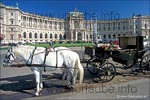
One does not necessarily get to one of the public traffic shops of Vienna in order to buy this card. As the card is also available in many hotels, one can comfortably buy it at the hotel's reception and also get the first information. Additionally to the card, one gets a brochure in which all discounts are listed. By this way, one gets some additional ideas which tips for excursions one probably wants to follow. The ring lines of Vienna are specially good for a stressless and specially cheap sightseeing tour all around the Ring Street of Vienna. By this way, one passes all important buildings of the centre without getting out and abstains from aching feet that will ache later in any case considering the wide distances of Vienna. If one then knows where the Hofburg, Museum Quarter, City Hall and the Opera are located, next time, one can get there straight away. During the summer months, an oldtimer tram of the year 1928/29 additionally circles up to the Prater. On each weekend and bank holiday, one can explore Vienna the way it was in former times, sitting on wooden benches and enjoy piece of nostlgia. Those who like to have it more nostalgic or maybe better said more romantic can be taken by one of the numerous fiakers to circle through Vienna. Even if the romance gets a little reduced by the steep prices, one has surely the best view and can be additionally further informed by the driver. Within the centre, the location of the fiakers is at the Albertina at the Helden Plaza, at the Stephans- and Peters Plaza. Maybe some additional words concerning the car in Vienna: As the parking places are rare in the centre of Vienna and also very expensive, specially if one risks to park somewhere without a parking ticket should better leave the car in the hotel. But be careful: many hotels offer underground parking places within the public parking facilities and these are tremenduously expensive. Shopping in ViennaWhat would be a city trip without an extended shopping tour? Of course, Vienna is the city of the castles, museums, churches and buildings, but Vienna is also an European capital where one can buy anything from the most modern labels up to traditional Austrian products. The main and shopping road is the Kärnter Street. This street begins at the State Opera and leads straight up to the St. Stephan Dome. 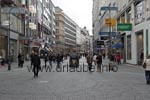
The Kärntner-Street is a pedestrian area: beside the hustle and bustle of the crowds of the shopping people are not disturbed by any traffic. Shortly before the St. Stephan's Dome, the "Graben" branches off to the left. This street is also still only for pedestrians and main shopping mile of Vienna. 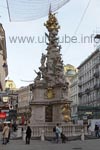
In the middle of all this, one comes across to the Trinity Column that is called the "Plague Column". It was built by the Emperor Leopold I after a long lasting pest plague took the lives of more than 100.000 people of Vienna in the year 1679 and was finally over. The more than 10 metres heighted Plague Column is impressive either by looking at it from a distance having a view to the complete column, as also form the proximity by looking at the details. Of course, it is a popular meeting point for the inhabitants of Vienna. But also the tourists like to meet at the Plague Column; this impressive building amidst the pedestrian area can simply not be overseen. By loafing alongside the Graben, one finds right after the Plague Column at the right the Peterskirche. Another bit further, the pedestrian road branches off again to the left; the street is then called Kohlmarkt. By walking alongside the Kohlmarkt, one finally gets to the Sankt Michaeler Church and stands on the Michaeler-Plaza; thus one stands right in front of the Hofburg. In the main shopping roads, one of course finds the famous world-labels that one finds in the centre of any big city.From Gucci to Hermes up to the famous jewellery shops, everything of distinction and/or what seeks distinction is represented by an own branch. It is self evident that in the shops of the core of the centre of Vienna, one can not shop for bargain prices. 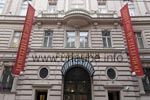
Parallel to the Kärntner Street there is the Dorotheum, a pawn office that is more than 200 years old. Art lovers, as also hunters and collectors find here antiques and oddities, from old books, stamps and coins to antique furniture and carpets up to arts in form of paintings and sculptures. Also those who are not a collect/hunter should visit the Dorotheum. 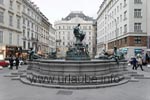
Also right beside the Kärntner street at the Neuer Markt (New Market) there is the famous Provedentia, also called Donnerbrunnen (Thunder Fountain). The name is not originated by thuinderbolt but from the baroque sculpturer Georg Raphael Donner (Donner=Thunder). Around the main monument amidst the fountain there are four additional small statues spread that represent the main four feeder rivers of the Danube in Austria. The Provedentia is also a popular meeting point. Those who prefer to buy in Vienna traditional and local products will find these aside the tourist streets. In Vienna, there is a traditional handcraft of porcelain or embroideries. Of course, one can buy some traditional liveries and costumes. And of course, many wine shops ar ehidden in the capital of Austria that buy best Austrian wines. 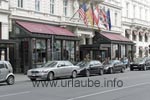
And, talking about the famous local specialities, an original schnitzel of Vienna (Wiener Schnitzel) should be enjoyed in Vienna. But the Sacher tart of Vienna is at least as famous as the scalopped schnitzel. And where is it possible to dine in the most traditional way? Of course in the café of the Hotel Sacher right behind the Opera. The Sacher tart is probably the biggest culinary invention made in Vienna. It is not easy to get a seat during the tea time in the Café Sacher. The famous Sacher tarte and other specialities can be also taken away. 
Copyright 2007-2008: Patrick Wagner, www.tourist-guide.biz |
||